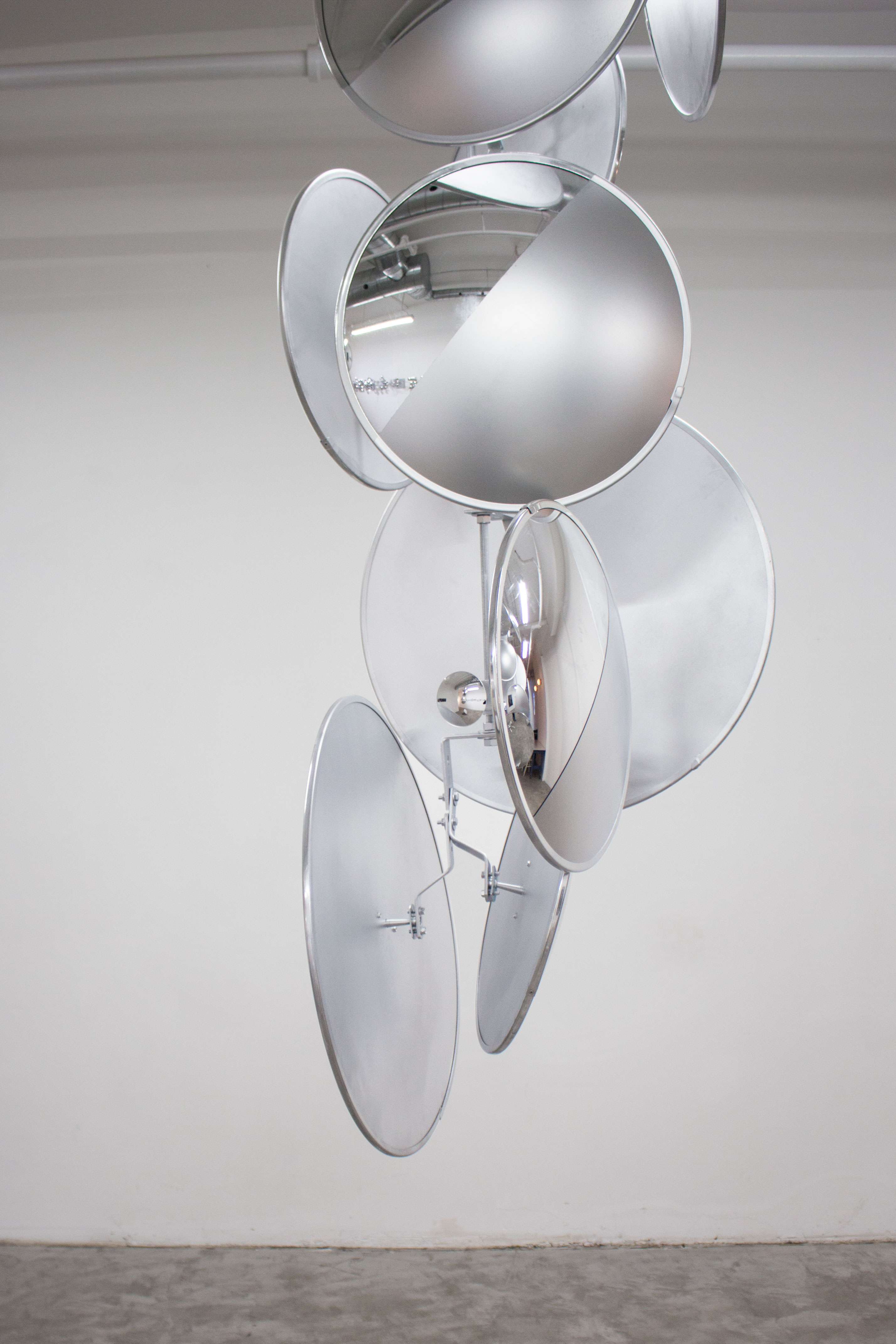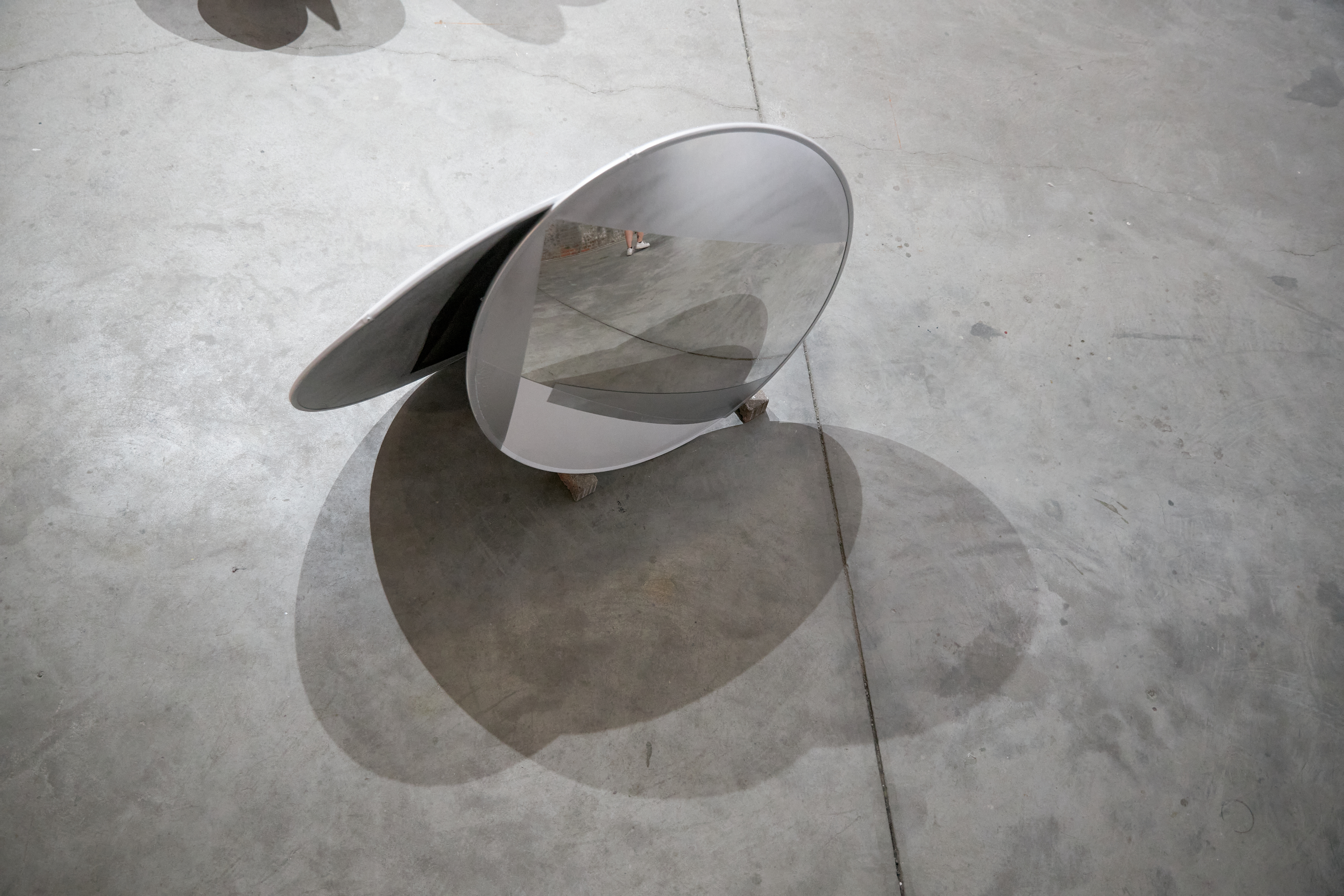

Blind Spot
(2018-on going) explores the complex economy that exists between things, structures, aesthetics, understanding, and social and normative contexts. The series brings together works in which circular mirrors of different sizes are presented together, sometimes overlapping. As the title suggests, the ability of these elements to reflect space is obstructed. On the surface of the mirrors, there are interventions with cutouts painted with automotive paint in colors that vary between blue, white, gray, green, among others. The opacity of the paint creates blind spots on the mirrors, preventing them from fully functioning as reflectors of the surroundings. The result is even more fragmented images and points of view, including color as an important element in the perception of space. These almost geometric interventions also reveal Gustavo Prado's interest in phenomenological vision and in dialogue with issues of Brazilian constructive heritage. In addition to the viewer's movement in front of the work, in Blind Spot there is a sense of movement generated by the gaze as it travels through the sequence of areas painted by the artist on the mirror surfaces.


Blind Spot
(2018-on going) explores the complex economy that exists between things, structures, aesthetics, understanding, and social and normative contexts. The series brings together works in which circular mirrors of different sizes are presented together, sometimes overlapping. As the title suggests, the ability of these elements to reflect space is obstructed. On the surface of the mirrors, there are interventions with cutouts painted with automotive paint in colors that vary between blue, white, gray, green, among others. The opacity of the paint creates blind spots on the mirrors, preventing them from fully functioning as reflectors of the surroundings. The result is even more fragmented images and points of view, including color as an important element in the perception of space. These almost geometric interventions also reveal Gustavo Prado's interest in phenomenological vision and in dialogue with issues of Brazilian constructive heritage. In addition to the viewer's movement in front of the work, in Blind Spot there is a sense of movement generated by the gaze as it travels through the sequence of areas painted by the artist on the mirror surfaces.










Blind Spot
(2018-on going) explores the complex economy that exists between things, structures, aesthetics, understanding, and social and normative contexts. The series brings together works in which circular mirrors of different sizes are presented together, sometimes overlapping. As the title suggests, the ability of these elements to reflect space is obstructed. On the surface of the mirrors, there are interventions with cutouts painted with automotive paint in colors that vary between blue, white, gray, green, among others. The opacity of the paint creates blind spots on the mirrors, preventing them from fully functioning as reflectors of the surroundings. The result is even more fragmented images and points of view, including color as an important element in the perception of space. These almost geometric interventions also reveal Gustavo Prado's interest in phenomenological vision and in dialogue with issues of Brazilian constructive heritage. In addition to the viewer's movement in front of the work, in Blind Spot there is a sense of movement generated by the gaze as it travels through the sequence of areas painted by the artist on the mirror surfaces.






Blind Spot
(2018-on going) explores the complex economy that exists between things, structures, aesthetics, understanding, and social and normative contexts. The series brings together works in which circular mirrors of different sizes are presented together, sometimes overlapping. As the title suggests, the ability of these elements to reflect space is obstructed. On the surface of the mirrors, there are interventions with cutouts painted with automotive paint in colors that vary between blue, white, gray, green, among others. The opacity of the paint creates blind spots on the mirrors, preventing them from fully functioning as reflectors of the surroundings. The result is even more fragmented images and points of view, including color as an important element in the perception of space. These almost geometric interventions also reveal Gustavo Prado's interest in phenomenological vision and in dialogue with issues of Brazilian constructive heritage. In addition to the viewer's movement in front of the work, in Blind Spot there is a sense of movement generated by the gaze as it travels through the sequence of areas painted by the artist on the mirror surfaces.





Blind Spot
(2018-on going) explores the complex economy that exists between things, structures, aesthetics, understanding, and social and normative contexts. The series brings together works in which circular mirrors of different sizes are presented together, sometimes overlapping. As the title suggests, the ability of these elements to reflect space is obstructed. On the surface of the mirrors, there are interventions with cutouts painted with automotive paint in colors that vary between blue, white, gray, green, among others. The opacity of the paint creates blind spots on the mirrors, preventing them from fully functioning as reflectors of the surroundings. The result is even more fragmented images and points of view, including color as an important element in the perception of space. These almost geometric interventions also reveal Gustavo Prado's interest in phenomenological vision and in dialogue with issues of Brazilian constructive heritage. In addition to the viewer's movement in front of the work, in Blind Spot there is a sense of movement generated by the gaze as it travels through the sequence of areas painted by the artist on the mirror surfaces.






Blind Spot
(2018-on going) explores the complex economy that exists between things, structures, aesthetics, understanding, and social and normative contexts. The series brings together works in which circular mirrors of different sizes are presented together, sometimes overlapping. As the title suggests, the ability of these elements to reflect space is obstructed. On the surface of the mirrors, there are interventions with cutouts painted with automotive paint in colors that vary between blue, white, gray, green, among others. The opacity of the paint creates blind spots on the mirrors, preventing them from fully functioning as reflectors of the surroundings. The result is even more fragmented images and points of view, including color as an important element in the perception of space. These almost geometric interventions also reveal Gustavo Prado's interest in phenomenological vision and in dialogue with issues of Brazilian constructive heritage. In addition to the viewer's movement in front of the work, in Blind Spot there is a sense of movement generated by the gaze as it travels through the sequence of areas painted by the artist on the mirror surfaces.






Blind Spot
(2018-on going) explores the complex economy that exists between things, structures, aesthetics, understanding, and social and normative contexts. The series brings together works in which circular mirrors of different sizes are presented together, sometimes overlapping. As the title suggests, the ability of these elements to reflect space is obstructed. On the surface of the mirrors, there are interventions with cutouts painted with automotive paint in colors that vary between blue, white, gray, green, among others. The opacity of the paint creates blind spots on the mirrors, preventing them from fully functioning as reflectors of the surroundings. The result is even more fragmented images and points of view, including color as an important element in the perception of space. These almost geometric interventions also reveal Gustavo Prado's interest in phenomenological vision and in dialogue with issues of Brazilian constructive heritage. In addition to the viewer's movement in front of the work, in Blind Spot there is a sense of movement generated by the gaze as it travels through the sequence of areas painted by the artist on the mirror surfaces.






Blind Spot
(2018-on going) explores the complex economy that exists between things, structures, aesthetics, understanding, and social and normative contexts. The series brings together works in which circular mirrors of different sizes are presented together, sometimes overlapping. As the title suggests, the ability of these elements to reflect space is obstructed. On the surface of the mirrors, there are interventions with cutouts painted with automotive paint in colors that vary between blue, white, gray, green, among others. The opacity of the paint creates blind spots on the mirrors, preventing them from fully functioning as reflectors of the surroundings. The result is even more fragmented images and points of view, including color as an important element in the perception of space. These almost geometric interventions also reveal Gustavo Prado's interest in phenomenological vision and in dialogue with issues of Brazilian constructive heritage. In addition to the viewer's movement in front of the work, in Blind Spot there is a sense of movement generated by the gaze as it travels through the sequence of areas painted by the artist on the mirror surfaces.






Blind Spot (2018-on going) explores the complex economy that exists between things, structures, aesthetics, understanding, and social and normative contexts. The series brings together works in which circular mirrors of different sizes are presented together, sometimes overlapping. As the title suggests, the ability of these elements to reflect space is obstructed. On the surface of the mirrors, there are interventions with cutouts painted with automotive paint in colors that vary between blue, white, gray, green, among others. The opacity of the paint creates blind spots on the mirrors, preventing them from fully functioning as reflectors of the surroundings. The result is even more fragmented images and points of view, including color as an important element in the perception of space. These almost geometric interventions also reveal Gustavo Prado's interest in phenomenological vision and in dialogue with issues of Brazilian constructive heritage. In addition to the viewer's movement in front of the work, in Blind Spot there is a sense of movement generated by the gaze as it travels through the sequence of areas painted by the artist on the mirror surfaces.



Blind Spot
(2018-on going) explores the complex economy that exists between things, structures, aesthetics, understanding, and social and normative contexts. The series brings together works in which circular mirrors of different sizes are presented together, sometimes overlapping. As the title suggests, the ability of these elements to reflect space is obstructed. On the surface of the mirrors, there are interventions with cutouts painted with automotive paint in colors that vary between blue, white, gray, green, among others. The opacity of the paint creates blind spots on the mirrors, preventing them from fully functioning as reflectors of the surroundings. The result is even more fragmented images and points of view, including color as an important element in the perception of space. These almost geometric interventions also reveal Gustavo Prado's interest in phenomenological vision and in dialogue with issues of Brazilian constructive heritage. In addition to the viewer's movement in front of the work, in Blind Spot there is a sense of movement generated by the gaze as it travels through the sequence of areas painted by the artist on the mirror surfaces.






Blind Spot
(2018-on going) explores the complex economy that exists between things, structures, aesthetics, understanding, and social and normative contexts. The series brings together works in which circular mirrors of different sizes are presented together, sometimes overlapping. As the title suggests, the ability of these elements to reflect space is obstructed. On the surface of the mirrors, there are interventions with cutouts painted with automotive paint in colors that vary between blue, white, gray, green, among others. The opacity of the paint creates blind spots on the mirrors, preventing them from fully functioning as reflectors of the surroundings. The result is even more fragmented images and points of view, including color as an important element in the perception of space. These almost geometric interventions also reveal Gustavo Prado's interest in phenomenological vision and in dialogue with issues of Brazilian constructive heritage. In addition to the viewer's movement in front of the work, in Blind Spot there is a sense of movement generated by the gaze as it travels through the sequence of areas painted by the artist on the mirror surfaces.







